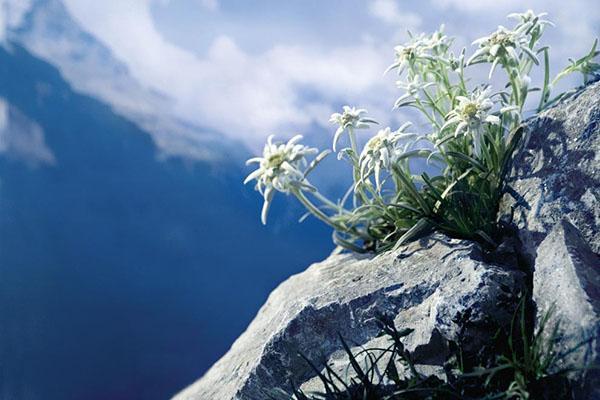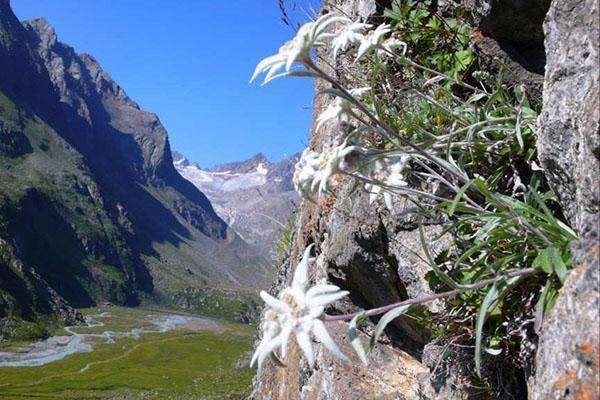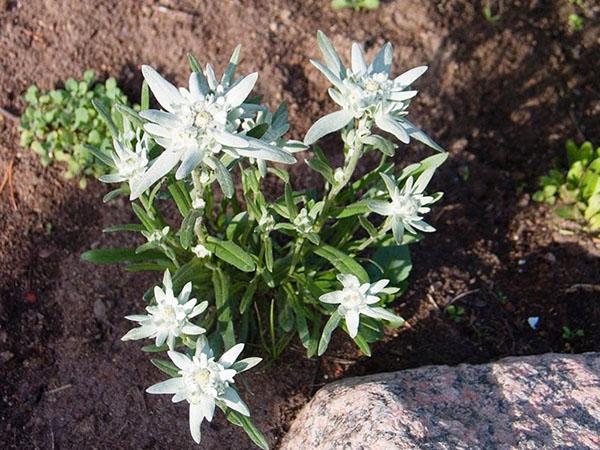Edelweiss - mountain flower of love at their summer cottage
 An amazing flower, shrouded in legends of eternal love and devotion, has been decorating flower beds of true color lovers for a long time. This miracle is called - edelweiss. Descending from the mountain slopes, he is not afraid of severe frosts, strong winds and summer heat. Its delicate buds with silk hairs endure natural adversity, remaining unchanged in their beauty. It was for this that the flower became a symbol of such valuable qualities as loyalty, love and devotion.
An amazing flower, shrouded in legends of eternal love and devotion, has been decorating flower beds of true color lovers for a long time. This miracle is called - edelweiss. Descending from the mountain slopes, he is not afraid of severe frosts, strong winds and summer heat. Its delicate buds with silk hairs endure natural adversity, remaining unchanged in their beauty. It was for this that the flower became a symbol of such valuable qualities as loyalty, love and devotion.
Today, there are many different legends associated with this persistent mountain flower. They reflect the amazing properties of this wonderful plant.
Edelweiss - persistent mountain flower

 At first glance, the flower may not seem very attractive. But having got to know him better, many appreciated it and began to grow it in their front gardens. Edelweiss got its name because of its external resemblance to the back of a lion's paw. This is exactly what its name sounds like in Latin - "Leontopodium". Indeed, when the buds open and become covered with an abundance of delicate villi, they resemble a cat's paw.
At first glance, the flower may not seem very attractive. But having got to know him better, many appreciated it and began to grow it in their front gardens. Edelweiss got its name because of its external resemblance to the back of a lion's paw. This is exactly what its name sounds like in Latin - "Leontopodium". Indeed, when the buds open and become covered with an abundance of delicate villi, they resemble a cat's paw.  The pictured edelweiss flower in the wild is true proof of this similarity.
The pictured edelweiss flower in the wild is true proof of this similarity.
The inhabitants of Switzerland consider this flower a symbol of their country and call it the "Queen of the Alps". If you want to create a piece of Switzerland on a flower bed, plant this particular flower.
Detailed description of the plant
 Many gardeners are well aware of what an edelweiss flower looks like in its natural environment. Therefore, do not be afraid to grow it in your summer cottages. Looking closely at the plant, you will notice that it consists of the following elements:
Many gardeners are well aware of what an edelweiss flower looks like in its natural environment. Therefore, do not be afraid to grow it in your summer cottages. Looking closely at the plant, you will notice that it consists of the following elements:
- Single erect shoots about 25 cm high.
- Basal rosette of lanceolate leaves lying on the soil.
- Delicate buds of white or yellow color, abundantly pubescent with silk pile.
 Edelweiss blooms in the middle of summer, when the last echoes of low temperatures disappear into oblivion. It decorates a flower bed for about 20 days, like the mountain slopes of the Alps in Switzerland. Its inflorescences consist of several original baskets in the form of twisted white or yellow buds. Around them are linear leaves covered with an abundance of delicate villi. Thanks to this combination, a pretentious star is formed, inherent in edelweiss.
Edelweiss blooms in the middle of summer, when the last echoes of low temperatures disappear into oblivion. It decorates a flower bed for about 20 days, like the mountain slopes of the Alps in Switzerland. Its inflorescences consist of several original baskets in the form of twisted white or yellow buds. Around them are linear leaves covered with an abundance of delicate villi. Thanks to this combination, a pretentious star is formed, inherent in edelweiss.
The petals of the buds are also abundantly pubescent, so it seems that they are poured out of wax. These tiny lumps seem to be peeping out from under the snow lying on the star-shaped leaf plates. Such beauty leaves no one indifferent, so many people like this mountain flower of love.
As a result of successful pollination, cylindrical achenes are formed on the peduncles containing many seeds. They can be used to propagate this wonderful flower.
Popular types of edelweiss
 Before you start growing this legendary plant, you should get acquainted with its popular species.Today biologists have counted about 40 different variants. Let's consider some of them.
Before you start growing this legendary plant, you should get acquainted with its popular species.Today biologists have counted about 40 different variants. Let's consider some of them.
Alpine
 In its natural environment, this type of edelweiss is found on open limestones, rocks or steep slopes. Small bushes (about 25 cm high) consist of several curved shoots that emerge from the root rosette. During the flowering period, buds collected in baskets appear, framed with star-shaped leaves. Thanks to the thick layer of villi, it looks like white snow is lying on the leaves. Truly an amazing sight!
In its natural environment, this type of edelweiss is found on open limestones, rocks or steep slopes. Small bushes (about 25 cm high) consist of several curved shoots that emerge from the root rosette. During the flowering period, buds collected in baskets appear, framed with star-shaped leaves. Thanks to the thick layer of villi, it looks like white snow is lying on the leaves. Truly an amazing sight!
To preserve the main features of the species, it is advisable to propagate the Alpine edelweiss in spring or autumn in a vegetative way.
Dwarf
 In nature, such edelweiss grows in the mountains at an altitude of 5000 m.Nevertheless, it is successfully grown on domestic flower beds... It grows only up to 10 cm. It has lanceolate leaves forming a rosette, in the center of which an inflorescence of 5 buds appears.
In nature, such edelweiss grows in the mountains at an altitude of 5000 m.Nevertheless, it is successfully grown on domestic flower beds... It grows only up to 10 cm. It has lanceolate leaves forming a rosette, in the center of which an inflorescence of 5 buds appears.
This miniature white edelweiss is best grown in rock gardens using drainage soil. It can be propagated using spring cuttings or autumn sowing of seeds.
Siberian
 Plants of this type form large bushes with large shoots and a leaf blade. White buds look original against the background of glossy dark green leaves. This variety is familiar with the name "Pilibina" and is very similar to the Alpine edelweiss. The only difference is in the size of the inflorescences. In its natural environment, it is found in the mountainous and steppe regions of Eurasia, as well as on the Korean Peninsula.
Plants of this type form large bushes with large shoots and a leaf blade. White buds look original against the background of glossy dark green leaves. This variety is familiar with the name "Pilibina" and is very similar to the Alpine edelweiss. The only difference is in the size of the inflorescences. In its natural environment, it is found in the mountainous and steppe regions of Eurasia, as well as on the Korean Peninsula.
When growing edelweiss in a summer cottage, it should be remembered that the plant loves permeable soil with a high lime content.
Kuril
 The flower only grows up to 15 cm in height. Its amazing inflorescences, 5 cm in diameter, are wonderfully combined with the dark green foliage of a linear character. Around the buds there are about a dozen rays, which are covered with white felt fibers. Kuril edelweiss begins to bloom in the middle of summer and only by autumn forms a cylinder-shaped achene. The flower is used to form stony alpine slideswhere it occupies a special place among plants.
The flower only grows up to 15 cm in height. Its amazing inflorescences, 5 cm in diameter, are wonderfully combined with the dark green foliage of a linear character. Around the buds there are about a dozen rays, which are covered with white felt fibers. Kuril edelweiss begins to bloom in the middle of summer and only by autumn forms a cylinder-shaped achene. The flower is used to form stony alpine slideswhere it occupies a special place among plants.
Bicolor
 The original edelweiss variety is striking in its pretentious beauty. Its low bushes up to 35 cm consist of basal pubescent leaves and erect shoots. When the time comes for flowering, white and yellow buds appear on them. Each of them is framed by leaf arrows of different lengths. This combination gives the plant a spectacular look and attractiveness.
The original edelweiss variety is striking in its pretentious beauty. Its low bushes up to 35 cm consist of basal pubescent leaves and erect shoots. When the time comes for flowering, white and yellow buds appear on them. Each of them is framed by leaf arrows of different lengths. This combination gives the plant a spectacular look and attractiveness.
Since edelweiss naturally grows in open areas, it should be grown in areas with great access to sunlight. In the shade, the plant may die.